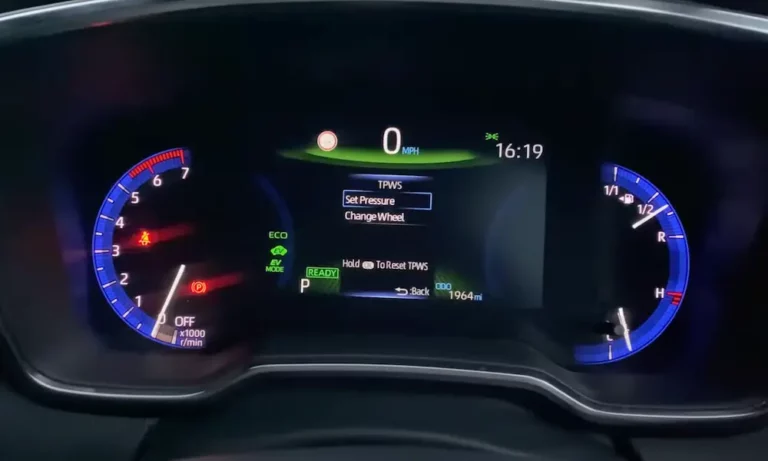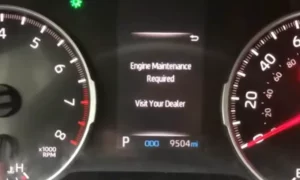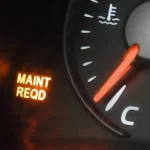Ever seen that annoying little tire icon light up on your Toyota dashboard? You’re not the only one staring at that warning light after filling your tires. The good news? Resetting your Toyota’s tire pressure sensors is often much simpler than most people think.
What Is the Toyota TPMS System?
Toyota’s Tire Pressure Monitoring System (TPMS) keeps an eye on your tire pressure while you drive. Most modern Toyotas use direct TPMS systems with actual sensors inside each tire that measure air pressure and send wireless signals to your car’s computer.
When pressure drops about 20-25% below the recommended level, that pesky warning light pops up on your dashboard. It’s actually a helpful safety feature that prevents accidents caused by underinflated tires.
Why Your Toyota’s Tire Pressure Light Comes On
That warning light isn’t just trying to annoy you. Here’s why it might be glowing:
- Your tire pressure dropped significantly
- The temperature outside changed dramatically (cold weather can lower tire pressure)
- You’ve got tire damage or a puncture
- You recently rotated or replaced your tires
- A TPMS sensor is acting up or needs a new battery
The Main Reset Button Method (Most Toyota Models)
For many Toyotas, the quickest reset method uses a dedicated button:
- Turn the car to “ON” position without starting the engine
- Find the TPMS reset button (usually under the steering wheel on the left side)
- Press and hold the button until the tire pressure light blinks three times
- Start your engine
- Drive normally for about 20 minutes to complete the reset
The button sometimes hides in sneaky spots. In some Toyota and Lexus models, you might need to reach underneath the dash to find it.
Digital Display Reset Method (Newer Models)
If you’ve got a newer Toyota (especially 2019 and later), you’ll likely need to reset through the dashboard menu:
- Use the steering wheel controls to find “Settings”
- Go to “Vehicle Settings”
- Select “TPMS” or “Tire Pressure Warning System”
- Press and hold “OK” until the system confirms the reset
This method is common on newer Corollas, RAV4s, and other recent Toyota models with digital displays. The menu layout might vary slightly between models.
Just Drive It Off (The Easy Method)
Sometimes, simply driving your Toyota can reset the system:
- Make sure all tires are properly inflated
- Drive at speeds over 50 mph for about 10 minutes
- The system should recalibrate and turn off the warning light
For direct TPMS systems, you might need to drive above 19 mph for at least 20 minutes. This gives the sensors time to communicate with the car’s computer and confirm everything’s normal.
Model-Specific Reset Instructions
Toyota Corolla (2020 and newer)
The 2020+ Corollas use a menu-based reset:
- Using steering wheel buttons, go to “Settings”
- Select “Vehicle Settings”
- Find “TPMS Setting”
- Press and hold the “OK” button until the system resets
Toyota RAV4 (2019 and newer)
RAV4 owners will follow a similar menu-based approach:
- Use the steering wheel arrows to access “Vehicle Settings”
- Navigate to “TPMS”
- Hold the “OK” button until confirmation appears
- Drive normally for the system to complete calibration
Toyota Camry Reset Procedure
The Camry typically uses the physical button method:
- Locate the TPMS button (usually under the steering column)
- With the car in “ON” position but engine off, hold the button
- Wait for the tire pressure light to blink three times
- Release the button and start the engine
Toyota Tacoma and Tundra Trucks
Toyota trucks often use the traditional reset button method, but the button location might differ:
- Look for a small button marked “TPMS” or with a tire symbol
- With ignition on, press and hold until the light blinks
- Start the engine and drive normally
When Standard Methods Don’t Work
Try these backup approaches if you’re still seeing that warning light:
Battery Disconnection Method
- Turn off your Toyota
- Disconnect the positive battery cable
- Turn the key to “ON” and press the horn for three seconds
- Reconnect the battery
This method essentially performs a “hard reset” of your Toyota’s electrical systems, which can sometimes clear stubborn TPMS warnings.
The Inflation/Deflation Reset Trick
As a last resort:
- Over-inflate all tires (including spare) by 3+ PSI above recommended level
- Completely deflate all tires
- Re-inflate to the proper pressure
This method forces the sensors to recognize the significant pressure changes, essentially “waking them up” to the new correct pressure.
Dealing with Multiple Sets of TPMS Sensors
If you switch between winter and summer tires with different sensors:
- Complete the standard reset after changing tire sets
- Drive at least 20 minutes above 19 mph
- For some models, you might need a TPMS relearn tool from an auto parts store
According to discussions among Toyota owners, this process helps the system recognize which set of sensors is currently active.
Keeping Your Tire Pressure Perfect
Prevention is better than constantly resetting warning lights:
| Season | Checking Frequency | What to Watch For |
|---|---|---|
| Winter | Every 2-3 weeks | Pressure drops with cold temperatures |
| Summer | Monthly | Heat can increase pressure above limits |
| All Year | Before long trips | Check all tires including spare |
Checking Pressure the Right Way
For accurate pressure readings:
- Check when tires are cold (parked for 3+ hours)
- Use a quality digital gauge (not the built-in ones at gas stations)
- Compare readings to the sticker in your driver’s door jamb, not what’s on the tire itself
- Don’t forget to check your spare tire pressure too
When to See a Professional
Sometimes the DIY approach isn’t enough. See a mechanic if:
- The warning light returns immediately after reset
- Your tire pressure is correct but the light won’t turn off
- The light flashes instead of staying solid
- You hear unusual sounds from the wheels
These could indicate a failing TPMS sensor battery or damaged sensor that needs replacement.
Understanding Toyota TPMS Battery Life
The sensors in your Toyota’s tires have batteries that eventually die:
- Typical TPMS sensor battery life: 5-10 years
- When they fail: Usually all around the same time
- Replacement cost: $35-$100 per sensor plus labor
- Warning signs: Intermittent TPMS warnings that won’t reset
Some Toyota dealerships offer package deals when replacing all four sensors at once, which can save you money in the long run.
Toyota TPMS System Benefits
The minor hassle of occasional resets is worth these safety benefits:
- Improved fuel economy (properly inflated tires save gas)
- Extended tire life and more even tread wear
- Better handling and shorter braking distances
- Reduced risk of blowouts and accidents
According to Toyota’s official information, properly maintained tire pressure can improve your gas mileage by up to 3%.
TPMS and Your Toyota’s Warranty
Good to know:
- TPMS sensors are typically covered under Toyota’s 3-year/36,000-mile basic warranty
- The reset procedure doesn’t void any warranty
- If your car is under warranty and having TPMS issues, visit your dealer
Final Tips for Toyota TPMS Success
Keep these points in mind for trouble-free tire pressure management:
- Always reset after tire rotations and replacements
- Consider seasonal pressure adjustments (slightly higher in summer, lower in winter)
- Keep a good tire pressure gauge in your glove compartment
- When replacing tires, consider new TPMS sensors if yours are older than 5 years
With these simple steps, you’ll keep that tire pressure light off and your Toyota running safely and efficiently for miles to come.














